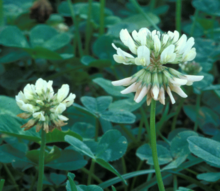What Is A Cover Crop In Gardening
- Home
- Yard and garden
- How-to
- Managing soil and nutrients
- Cover crops and green manures
Quick facts
- Cover crops form a living mulch in gardens because they grow thickly among each other.
- They help reduce soil splash and erosion, and keep weeds in check.

Cover crops form a living mulch in gardens because they grow thickly among each other. They help reduce soil splash and erosion, and keep weeds in check.
Cover crops are "green manures" when a gardener turns them into the soil to provide organic matter and nutrients. Green manures include legumes such as vetch, clover, beans and peas; grasses such as annual ryegrass, oats, rapeseed, winter wheat and winter rye; and buckwheat.
Planting cover crops
Some gardeners sow cover crops plants in spring, especially in new garden plots to improve the soil and choke out weeds. In established vegetable or flower gardens, plant a green manure early in the season to improve the soil. After you turn it under, plant warm-season vegetables, bedding plants or container-grown perennials.
If you dig a new garden bed in spring or early summer, grow one or two crops of heat-loving buckwheat or beans. If you start a new garden in late summer, plant ryegrass, rapeseed or oats, which grow quickly in cool weather.
In late fall or the following spring, turn in the dead plant material and plant flowers or vegetables in the new, improved bed. The soil will contain more organic matter and beneficial microorganisms. There will be fewer weeds than before.
Use green manures in established vegetable gardens after you harvest early-maturing vegetables. You can plant green manure where these vegetables were growing to keep the garden weed-free, prevent soil erosion and add organic matter to the soil. Turn in the dead plant material after a killing frost in late fall.
Sow the seed thickly to create a cover that will not allow weeds to compete. Mow the plants down if they flower, to prevent them from self-seeding and becoming weeds themselves. In spring, turn dead plant material from green manures into the soil before sowing seeds or transplanting seedlings. This is also the time to add fertilizer to the soil. If the green manure does not die over winter, wait about two weeks after you turn in the living plant material before seeding or transplanting.
Nitrogen fixation
Many plants in the legume family, such as peas, beans, vetch and clover, grow in cooperation with soil-dwelling bacteria. These bacteria live in nodules on the roots of legumes. They take nitrogen gas from the air and convert it to a form plants can use. This process is "fixing nitrogen."
When the legume dies and its roots begin to decompose, residual nitrogen in the nodules becomes available to other plants. Minnesota farmers take advantage of nitrogen fixation when they plant soybeans in rotation with corn. The soybeans fix nitrogen in the soil. The following year, the corn plants use the nitrogen.
Most soils in Minnesota have adequate populations of the bacteria needed to form the association with legumes. You may choose to buy a powdered inoculum containing the bacteria when you buy the legume seed, to ensure that fixation occurs. In order to create enough fixed nitrogen in the soil to nourish future plants, you must grow leguminous cover crops for an entire season.
Most commonly grown green manures in Minnesota
|
- A thick mat of oats or ryegrass prevents erosion and keeps weeds out.
- Although they will grow in cool weather, both die over winter.
- Chemicals released as ryegrass decomposes may keep small seeds from germinating, such as those of carrot and lettuce.
- These broadleaf plants grow quickly in warm weather and effectively smother weeds.
- Buckwheat flowers are a favorite nectar source for bees.
- If you allow either of these species to flower and set seed, hundreds of plants will come up the next year.
- Buckwheat has no frost tolerance.
- Rapeseed may survive mild winters.
- Clovers fix nitrogen.
- Many are somewhat winter-hardy and may begin growth again in spring.
- The giant variety of white clover known as 'Ladino' makes a particularly good cover crop.
- Like clover, vetch and alfalfa fix nitrogen.
- They will survive winter and grow again in spring.
- These are legumes and fix nitrogen.
- You can grow them as both green manures and edible crops.
- Harvest the pods, and then turn the plants under.
- If sown in fall or late summer, they will die over winter.
- These grains are cold hardy. If planted in late summer, they will begin growing again in early spring.
- They are good for areas that you will plant late in spring with warm-season vegetables such as tomatoes, peppers or squash.
- Turn the green manure into the soil in mid-May, then plant heat-loving vegetables at the end of the month or in early June.
- Rye can develop a very extensive and tough root system that may be difficult to break up, making tilling and planting more difficult. Rye also has the same allelopathic qualities as ryegrass.
Reviewed in 2018
What Is A Cover Crop In Gardening
Source: https://extension.umn.edu/how-manage-soil-and-nutrients-home-gardens/cover-crops-and-green-manures#:~:text=Cover%20crops%20are%20%E2%80%9Cgreen%20manures,and%20winter%20rye%3B%20and%20buckwheat.
Posted by: tathamferamplon.blogspot.com

0 Response to "What Is A Cover Crop In Gardening"
Post a Comment